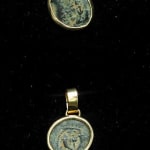Bronze Coin of High Priest John Hyrcanus II, 70 BCE - 40 CE
Bronze-Gold
FJ.5265
Mounted in a stunning 18 karat gold pendant. With the decline in power of the ruling Seleucid dynasty of Syria in the second century B.C., the Hasmoneans began to assert...
Mounted in a stunning 18 karat gold pendant.
With the decline in power of the ruling Seleucid dynasty of Syria in the second century B.C., the Hasmoneans began to assert a greater political independence for the Jewish people. Upon the death of Alexander Janaeus in 76 B.C., his widow Salome Alexandra took over the reign of power. However, because a woman could not hold the office of high priest, this title was given to her son by Jannaeus, John Hyrcanus II. When Salome died in 67 B.C., a civil war broke out between Hyrcanus and his brother Aristobulus II which lasted four years, until the Roman general Pompey intervened. Pompey then conquered Jerusalem but left the powers of John Hyrcanus as high priest intact. From this time onward, the Romans took an active hand in the political affairs of Judea. One of John Hyrcanus' chief advisors was Antipater the Idumean who saw that his own son Herod was eventually installed on the throne after the death of Hyrcanus in 40 B.C.
This beautiful bronze coin, minted during the reign of John Hyrcanus II, features the image of a double cornucopia adorned with ribbons and a pomegranate rising between horns. The other side of the coin displays a Hebrew inscription. Mounted in a regal gold pendant setting, this bronze coin is a radiant symbol of the ancient light of hope that has sustained the Jewish people for centuries.
With the decline in power of the ruling Seleucid dynasty of Syria in the second century B.C., the Hasmoneans began to assert a greater political independence for the Jewish people. Upon the death of Alexander Janaeus in 76 B.C., his widow Salome Alexandra took over the reign of power. However, because a woman could not hold the office of high priest, this title was given to her son by Jannaeus, John Hyrcanus II. When Salome died in 67 B.C., a civil war broke out between Hyrcanus and his brother Aristobulus II which lasted four years, until the Roman general Pompey intervened. Pompey then conquered Jerusalem but left the powers of John Hyrcanus as high priest intact. From this time onward, the Romans took an active hand in the political affairs of Judea. One of John Hyrcanus' chief advisors was Antipater the Idumean who saw that his own son Herod was eventually installed on the throne after the death of Hyrcanus in 40 B.C.
This beautiful bronze coin, minted during the reign of John Hyrcanus II, features the image of a double cornucopia adorned with ribbons and a pomegranate rising between horns. The other side of the coin displays a Hebrew inscription. Mounted in a regal gold pendant setting, this bronze coin is a radiant symbol of the ancient light of hope that has sustained the Jewish people for centuries.



